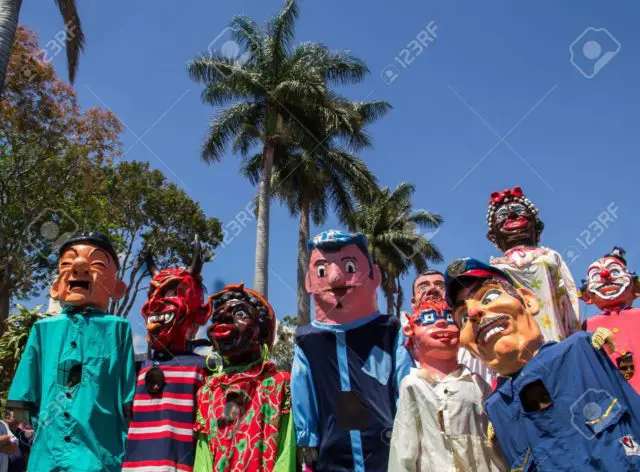The National Masquerade Day of Costa Rica is the holiday where both children and adults are chased by a giant devil. It is celebrated with the Pisuicas, the Llorona, the Segua and other legendary characters.
The traditional Costa Rican Masquerade is a tradition that has roots in the colonial era of the country, and currently continues to be very popular. Its origin seems to be the product of colonial and Native American festive practices. It is related to the Spanish holiday of the “giants and bigheads”, with direct influences from indigenous communities, which gives its origin a pluricultural and syncretic character.
The different characters represented by the masks created to receive the name of “mantudos” or clowns, and are characterized by strolling through the streets of the villages during the various popular or religious festivities chasing the attendees, dancing to the sound of “Cimarron” (Maroon) music and accompanied by fireworks.
What is a Masquerade?

In Costa Rica, we have all celebrated the sound of Maroon music at some point. In this celebration, there is no lack of frights and laughter. The “mantudos” or “clowns”, as they are called are responsible for chasing all those present and nobody is spared! Some of the characters that can not be missed are the Devil, Death, the Headless Father and, of course, the famous Giganta, inspired by the “plated” ladies of colonial Costa Rica. Without a doubt, the best way to know more about what a masquerade is to live it.
History
Before the arrival of the Spaniards to the territory of Costa Rica in the 16th century, the aboriginal peoples had some traditions that included the elaboration and use of masks. The most prominent of these traditions, which has come to the present, is the game of the “Devils of Boruca”. This festival of indigenous Boruca roots before the Conquest involves the elaboration of masks based on raft wood, with which the participants of the play of the devils disguise themselves. It takes place between December 31 and January 2 of each year.
In archaeological excavations carried out in the southern area of Costa Rica, where the Borucas tribes lived, there have been discovered gold pieces that represent masked characters, as well as dancers and musicians. After the Conquest, a new element was added, the bull, a character that represents the Spanish conqueror. Pre-Hispanic masks were made of diverse materials (clay, volcanic stone, wood, and jade), they were colored with natural pigments, and their themes were typical of the indigenous world view. The masked characters performed ritual dances, which gave them a privileged place and empowered them in indigenous society, as it was interpreted to be transformed or possessed by the deity that represented the mask.
Colonial-era: the “Parmampanes”
“Parmampanes” are considered as the immediate predecessors to the traditional masquerade as it is currently known they were groups of neighbors of generally humble condition, who disguised themselves in ridiculous costumes that used masks representing animals. During the colonial era, in the city of Cartago, before the start of bullfights during the popular or religious festivities, the parades included dancing and running around the audience.
In the Colony, the masks were made of paper mache. In them, there was a religious syncretism with Spanish, indigenous and African influences. Attendees dressed in blankets (where the term “mantudo” comes from), to which they made holes for the eyes, nose, and mouth, on which the masks were placed.
The festivities of “La Negrita”: the first Carthaginian masquerade
The first masquerade was organized in the town of Cartago by Rafael “Lito” Valerín, on August 2, 1824, for the occasion of the celebrations in honor of the Virgin of the Angels, Patroness of Costa Rica, affectionately called “La Negrita” by the Costa Rican people.
Rafael Valerín, born in the “Los Angeles barrio” of Cartago (also known as the Puebla de los Pardos, where according to legend, the image of the Virgin of the Angels appeared), was also a masked craftsman, plumber, hatmaker, and watchmaker. In 1824 he dedicated himself to the elaboration of puppets made out of the jícaro plant, also the manufacture of instruments such as guitars, violins, bandolines, and marimbas. Tradition tells that once, he, as a collaborator of the Church of the Virgin of the Angels, found an old trunk where masks of big heads of Spanish origin were kept. After closing the trunk out of fear, in another corner, he found another head mask. Valerín interpreted that as a message from the Virgin, and taking the head he had found, he built a wooden frame where he placed the mask, giving rise to the first “Giganta”. From there, Rafael Valerín made other masks using disposable paper, paste and sieve, which he mixed with the tradition of the “mantudos” (which were called some people who wrapped themselves in colored blankets with holes for the eyes and nose in the face), taking them out on the festivities to receive the pilgrims who approached to visit the Virgin of the Angels.
In 1918, Jesús Valerín, son of Rafael, continued the tradition and dedicated himself professionally to the manufacture of masquerades, using clay brought from “Tejar del Guarco”, paper, plaster, and wire. In 1930, in his old age, Jesús Valerín sold the molds of the masquerades to the brothers Pedro and Manuel Freer, who, for the first time, took the masquerade to the feasts of San José in Zapote.
The National Masquerade Day festivities include cultural and educational activities, elaboration and exhibition of masks, parades of the “mantos” accompanied by folk music, preparation and sale of typical foods, pyrotechnical games and tributes to prominent masqueraders. Each year, a National Meeting of the Traditional Costa Rican Masquerade is organized in one of the cantons of the country exhibiting this great mask tradition.

